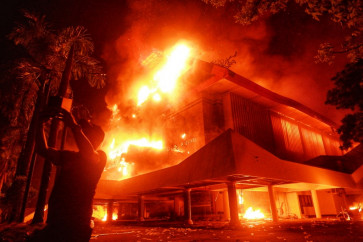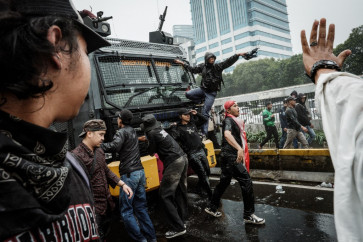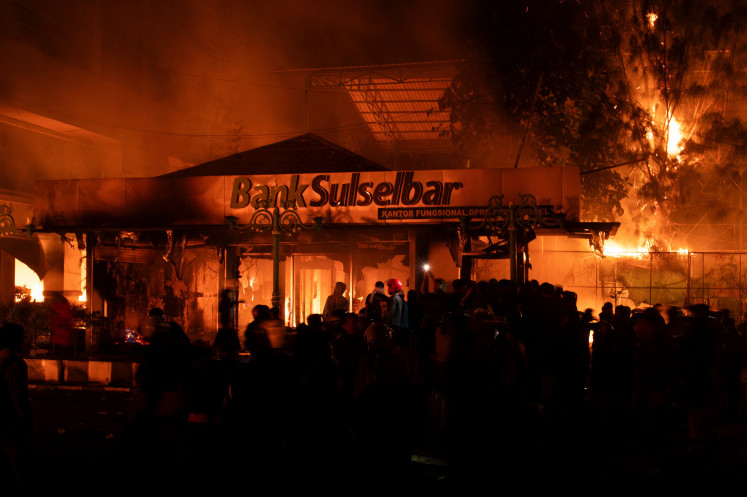Popular Reads
Top Results
Can't find what you're looking for?
View all search resultsPopular Reads
Top Results
Can't find what you're looking for?
View all search resultsVolcano Museum reveals the mystery of Mt. Batur
Looking at a distance: Visitors at the museum can view Mount Batur and Lake Batur from the fourth floor
Change text size
Gift Premium Articles
to Anyone
Looking at a distance: Visitors at the museum can view Mount Batur and Lake Batur from the fourth floor. JP/Wasti Atmodjo
Once, Hyang Pasupati, the god who resided on the top of Mt. Semeru in East Java, wanted to remove part of the mountain's peak to Bali to secure the land beneath the tiny island.
The peak on his right hand became Mt. Agung and the land on his left became Mt. Batur. So the story goes according to the myth of Bedawang Nala, displayed in the lobby of the Mt. Batur Volcano Museum in the Kintamani resort area, Bangli regency, 50 kilometers northeast of Denpasar.
Myths and legends surrounding the emergence of Mt. Batur have been retold for generations among the local Balinese, especially those living adjacent to the volcano, believed to be the island's first settlement area.
For both local and foreign visitors, Kintamani resort area offers one of the most scenic tourist sites on the island with its dark-blue Lake Batur and the eight and half mile-long Mt. Batur caldera, although many tourists are annoyed by the many street vendors and crowded streets.
Few visitors notice the Mt. Batur Volcano Museum, located within Penelokan (meaning the view or lookout in the Balinese language).
Built on a 2-hectare of plot of land, the four-story building, commissioned by the Ministry of Mining and Energy's Directorate of Volcanology and Geology, includes several sections, each explaining the origins of Mt. Batur and other volcanoes in Bali.
Tickets are sold from Rp 5,000 (US 50 cents) to Rp 10,000. Visitors are mostly school students who are eager to learn more about the island's geographic conditions.
"We are now actively promoting this facility among school students and the general public because only a very few people know about the museum as it was only opened two years ago," explained Siti Handayani.
The museum is open to the public every day from 9 a.m. through to 4 p.m., except on Balinese Hindu holidays. The Museum is also open on Sundays and national holidays, she said.
It is a pity the museum only receives around ten visitors every day on average. Although Siti says she expects the museum to receive more visitors in the June and July school holiday season.
The museum is actually rich in information on every aspect of volcanoes and other geological issues. Students can really benefit from the information and knowledge and could adopt it into their science projects.
Through a series of panels and documentary films, visitors are able to learn about the emergence of volcanoes in Indonesia and Bali in particular.
According to a study by the Directorate of Volcanology and Geology, the geography of Indonesia is dominated by volcanoes that were formed due to subsided zones between the Eurasian plate and Indo-Australian plate.
Some of the volcanoes are notable for their major eruptions, such as Krakatau in Sunda Strait. There are dozens of active volcanoes including Mt. Merapi and Kelud in Java, Mt. Agung in Bali, Tambora in West Nusa Tenggara and many others.
Indonesia has an estimated 500 volcanoes, 129 of them are active volcanoes (13 percent of the total active volcanoes in the world). Other panels in the museum scientifically explain Mt. Batur and Mt. Agung in Bali.
Mt. Batur was previously taller than Mt. Agung (which had major eruption in l963). Thousands of years ago, major eruptions exploded huge amounts of magma, ash and lava causing the magma chamber beneath the volcano to empty.
Mt. Batur experienced major eruptions during the pre-historic period forming the caldera and secondary volcano. Part of the caldera began to fill with water and formed Lake Batur. Mt. Batur erupted in l888, 1915, 1921, 1926, and l963.
Visitors are now able to view the changes in the forms of the Mt. Batur volcano and caldera through various panels, graphics and films.
Two computers are available for any visitor who wants to learn more about Mt. Batur and other volcanoes in Indonesia.
On the third floor, people can view Mt. Batur using a large variety of equipment provided by the museum's management. For most Balinese Hindus, Mt. Batur and Mt. Agung are considered very sacred sites where the gods and goddesses reside.
Volcanoes rule every facet of the Balinese people's lives. They create fertile soils and help produce downpours and water that sustain its centuries-old agricultural society. On the shores of Lake Batur live Trunyan Bali Aga (indigenuos Balinese descendants of the prehistoric settlers) isolated from modern Balinese life.
The museum can actually act as a window into the richness of Balinese geological conditions and the mystery of the people and myths of Mt. Batur.
A lack of promotional activities and unattractive displays always hamper people from visiting any museum in Bali and Indonesia alike.
The museum's management has a difficult time attracting people, students in particular, to enjoy the facility, which was quite expensive to build.
Adianto, a visitor from Jakarta, said that Mt. Batur Volcano Museum is quite informative and attractive, but he wondered why so few people visited.
"This museum is worth visiting - it is a learning center and a place to contemplate the richness of Balinese soils and the blessing of God that created such an amazing volcano," Adianto said.










